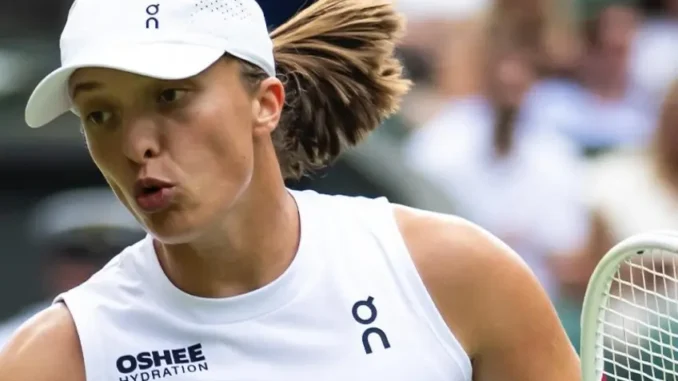
As the 2025 Wimbledon Championships unfold on the pristine grass courts of the All England Club, the women’s draw has been rocked by a wave of early upsets, prompting renewed chatter about the perceived inconsistency of the WTA Tour. Polish tennis superstar Iga Swiatek, the world number four and a five-time Grand Slam champion, has forcefully pushed back against this narrative, arguing that she, alongside Aryna Sabalenka and Coco Gauff, have been pillars of consistency in a demanding sport. Swiatek’s comments, delivered after a gritty three-set victory over American Caty McNally, underscore her frustration with critics who overlook the challenges of a grueling tour schedule and the unique unpredictability of grass-court tennis.
The 24-year-old from Warsaw has been a dominant force in women’s tennis, amassing 22 WTA titles, including four French Open crowns and a US Open triumph. Yet, Wimbledon 2025 has seen a string of shock exits, with three of the top five seeds—Coco Gauff, Jessica Pegula, and Zheng Qinwen—falling in the first round, followed by second-round losses for Jasmine Paolini and Madison Keys. Only four top-10 players remain as the tournament approaches the third round, fueling critics’ claims that the WTA lacks the predictability seen in the men’s game. Swiatek, however, sees a different story. “I don’t feel that,” she said firmly in her post-match press conference. “Me and Aryna and Coco have been winning a lot. Sometimes we lose early, because the schedule is pretty crazy. You can’t win everything.”
Swiatek’s 2025 season has been a testament to her resilience, with a 37-11 record and a runner-up finish at the Bad Homburg grass-court final, her first WTA final since her 2024 French Open triumph. Her Wimbledon campaign began with a 7-5, 6-1 victory over Polina Kudermetova, followed by a hard-fought 5-7, 6-2, 6-1 comeback against McNally, marking her 22nd consecutive Grand Slam third-round appearance. “I feel like on grass there are many upsets every year,” Swiatek noted, attributing the early exits to the surface’s unique challenges. “It doesn’t really matter what happens here when we go to the hard court season, I would say.” Her perspective highlights the difficulty of transitioning from clay to grass, a shift that demands rapid adaptation to a slicker, faster surface.
The narrative of WTA inconsistency has long been a point of contention, often used to undermine the women’s game. Swiatek, Sabalenka, and Gauff, however, have consistently delivered at the highest level. Sabalenka, the world number one, captured the 2025 Australian Open and WTA 1000 titles in Miami and Madrid, while Gauff, the reigning French Open champion, added a second major to her resume. Swiatek’s own dominance on clay, where she’s won four of the last five French Opens, is unparalleled, and her ability to reach deep stages in tournaments across surfaces speaks to her versatility. Yet, the relentless tennis calendar, which Swiatek has previously criticized, takes a toll. “Sometimes we lose early, because the schedule is pretty crazy,” she reiterated, echoing sentiments she expressed earlier this year about the need for fewer mandatory tournaments to protect player well-being.
Swiatek’s next challenge at Wimbledon is a third-round clash with American Danielle Collins, a player she leads 7-2 in their head-to-head but who stunned her in straight sets at the 2025 Italian Open. Collins, known for her aggressive style and strong serving, poses a formidable threat on grass, where she boasts an 80% first-serve point win rate. Swiatek, however, remains the favorite, buoyed by her recent grass-court final and a career-best Wimbledon quarter-final in 2023. Her junior Wimbledon singles title in 2018, which she described as feeling like “a different lifetime,” adds a layer of nostalgia to her campaign, though she remains grounded. “I thought maybe life is going to be, like, perfect now,” she reflected on her junior triumph. “I was a bit disappointed. It was still the same, and I still had to get back to work.”
The broader context of Wimbledon 2025 underscores the competitive depth of the WTA. While upsets have dominated headlines, players like Sabalenka, Mirra Andreeva, and Emma Navarro continue to shine, joining Swiatek in the third round. The men’s draw, too, has seen its share of surprises, with top-10 players like Alexander Zverev and Holger Rune exiting early, suggesting that volatility is not exclusive to the women’s game. Swiatek’s defiance of the inconsistency narrative is a call to recognize the strength and depth of the WTA Tour, where emerging talents and seasoned veterans alike create a fiercely competitive landscape. As she prepares for Collins, Swiatek’s focus is clear: to channel her clay-court dominance onto grass and prove that consistency is not just about winning every match, but about showing up, fighting, and adapting in the face of relentless challenges.
Leave a Reply